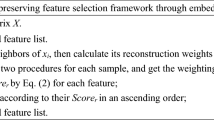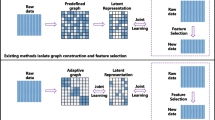Abstract
Feature selection is an important step for high-dimensional data clustering, reducing the redundancy of the raw feature set. In this paper, we focus on graph-based embedded feature selection and introduce a self-expressiveness property induced structured optimal graph feature selection (SPSOG-FS) algorithm. The proposed model incorporates both the advantages of data self-expressive property and the structured optimal graph (SOG) model. Specifically, in SPSOG-FS, a simple yet effective self-expressiveness constraint is proposed to thoroughly investigate the relations between local features. Simultaneously, we apply the SOG model to keep the original data’s local structure in low-dimensional space. As a result, both feature interaction and the local structural similarity of samples are taken into consideration. In addition, we also propose an efficient method named “density peaks-based automatic clustering” (DPBAC) to estimate the number of clusters, which is a necessary prior in graph-based FS but usually unknown in real-world scenarios. According to experimental results on benchmark datasets, our proposed FS approach outperforms numerous state-of-the-art methods. Additionally, the experiments demonstrate DPBAC’s capability for determining the number of clusters.




Similar content being viewed by others
Explore related subjects
Discover the latest articles, news and stories from top researchers in related subjects.Data availability
The datasets generated during and/or analyzed during the current study are available in the UCI repository, http://archive.ics.uci.edu/ml/.
References
AlSukker A, Khushaba RN, Al-Ani A (2010) Enhancing the diversity of genetic algorithm for improved feature selection. In: 2010 IEEE international conference on systems, man and cybernetics, IEEE, pp 1325–1331
Belhumeur PN, Hespanha JP, Kriegman DJ (1997) Eigenfaces vs. fisherfaces: recognition using class specific linear projection. IEEE Trans Pattern Anal Mach Intell 19(7):711–720
Belkin M, Niyogi P (2001) Laplacian eigenmaps and spectral techniques for embedding and clustering. In: Nips, pp 585–591
Cai D, Zhang C, He X (2010) Unsupervised feature selection for multi-cluster data. In: Proceedings of the 16th ACM SIGKDD international conference on Knowledge discovery and data mining, pp 333–342
Chandrashekar G, Sahin F (2014) A survey on feature selection methods. Comput Electr Eng 40(1):16–28
Cole R, Fanty M (1990) Spoken letter recognition. In: Speech and natural language: proceedings of a workshop held at Hidden Valley, Pennsylvania, pp 24–27
Ding D, Yang X, Xia F et al (2020) Unsupervised feature selection via adaptive hypergraph regularized latent representation learning. Neurocomputing 378:79–97
Ding J, He X, Yuan J et al (2018) Automatic clustering based on density peak detection using generalized extreme value distribution. Soft Comput 22(9):2777–2796
Elhamifar E, Vidal R (2013) Sparse subspace clustering: algorithm, theory, and applications. IEEE Trans Pattern Anal Mach Intell 35(11):2765–2781
Ester M, Kriegel HP, Sander J et al (1996) A density-based algorithm for discovering clusters in large spatial databases with noise. In: kdd, pp 226–231
Fan K (1949) On a theorem of Weyl concerning eigenvalues of linear transformations i. Proc Natl Acad Sci USA 35(11):652
Guyon I, Elisseeff A (2003) An introduction to variable and feature selection. J Mach Learn Res 3:1157–1182
Hall MA (2000) Correlation-based feature selection of discrete and numeric class machine learning
Hancer E, Xue B, Zhang M (2018) Differential evolution for filter feature selection based on information theory and feature ranking. Knowl Based Syst 140:103–119
Hou C, Nie F, Li X et al (2013) Joint embedding learning and sparse regression: a framework for unsupervised feature selection. IEEE Trans Cybern 44(6):793–804
Hull JJ (1994) A database for handwritten text recognition research. IEEE Trans Pattern Anal Mach Intell 16(5):550–554
Khan J, Wei JS, Ringner M et al (2001) Classification and diagnostic prediction of cancers using gene expression profiling and artificial neural networks. Nat Med 7(6):673–679
Lee M, Lee J, Lee H et al (2015) Membership representation for detecting block-diagonal structure in low-rank or sparse subspace clustering. In: Proceedings of the IEEE conference on computer vision and pattern recognition, pp 1648–1656
Li X, Zhang H, Zhang R et al (2018) Generalized uncorrelated regression with adaptive graph for unsupervised feature selection. IEEE Trans Neural Netw Learn Syst 30(5):1587–1595
Li Y, Li T, Liu H (2017) Recent advances in feature selection and its applications. Knowl Inf Syst 53(3):551–577
Longford NT (1987) A fast scoring algorithm for maximum likelihood estimation in unbalanced mixed models with nested random effects. Biometrika 74(4):817–827
Lyons MJ, Budynek J, Akamatsu S (1999) Automatic classification of single facial images. IEEE Trans Pattern Anal Mach Intell 21(12):1357–1362
Ma Z, Yang Y, Nie F et al (2011) Exploiting the entire feature space with sparsity for automatic image annotation. In: Proceedings of the 19th ACM international conference on multimedia, pp 283–292
Ma Z, Nie F, Yang Y et al (2012) Discriminating joint feature analysis for multimedia data understanding. IEEE Trans Multimedia 14(6):1662–1672
Miao J, Niu L (2016) A survey on feature selection. Procedia Comput Sci 91:919–926
Moradi P, Gholampour M (2016) A hybrid particle swarm optimization for feature subset selection by integrating a novel local search strategy. Appl Soft Comput 43:117–130
Nene S, Nayar S, Murase H et al (1996) Columbia object image library (coil-20)
Nie F, Huang H, Cai X et al (2010) Efficient and robust feature selection via joint \({{\ell }_{2,1}}\)-norms minimization. Adv Neural Inf Process Syst 23
Nie F, Wang X, Huang H (2014) Clustering and projected clustering with adaptive neighbors. In: Proceedings of the 20th ACM SIGKDD international conference on Knowledge discovery and data mining, pp 977–986
Nie F, Zhu W, Li X (2016) Unsupervised feature selection with structured graph optimization. In: Proceedings of the AAAI conference on artificial intelligence
Pearson KX (1900) On the criterion that a given system of deviations from the probable in the case of a correlated system of variables is such that it can be reasonably supposed to have arisen from random sampling. Lond Edinb Dublin Philos Mag J Sci 50(302):157–175
Peng X, Tang H, Zhang L et al (2015) A unified framework for representation-based subspace clustering of out-of-sample and large-scale data. IEEE Trans Neural Netw Learn Syst 27(12):2499–2512
Ray S, Turi RH (1999) Determination of number of clusters in k-means clustering and application in colour image segmentation. In: Proceedings of the 4th international conference on advances in pattern recognition and digital techniques, Citeseer, pp 137–143
Ren P, Xiao Y, Chang X et al (2020) Structured optimal graph-based clustering with flexible embedding. IEEE Trans Neural Netw Learn Syst 31(10):3801–3813
Rodriguez A, Laio A (2014) Clustering by fast search and find of density peaks. Science 344(6191):1492–1496
Sanguinetti G, Laidler J, Lawrence ND (2005) Automatic determination of the number of clusters using spectral algorithms. In: 2005 IEEE workshop on machine learning for signal processing, IEEE, pp 55–60
Shi C, Ruan Q, An G (2014) Sparse feature selection based on graph Laplacian for web image annotation. Image Vis Comput 32(3):189–201
Shi L, Du L, Shen YD (2014b) Robust spectral learning for unsupervised feature selection. In: 2014 IEEE international conference on data mining, IEEE, pp 977–982
Tabakhi S, Moradi P, Akhlaghian F (2014) An unsupervised feature selection algorithm based on ant colony optimization. Eng Appl Artif Intell 32:112–123
Wang F, Zhu L, Li J et al (2021) Unsupervised soft-label feature selection. Knowl Based Syst 219(106):847
Wang W, Yan Y, Nie F et al (2018) Flexible manifold learning with optimal graph for image and video representation. IEEE Trans Image Process 27(6):2664–2675
Yang Y, Shen HT, Ma Z, et al (2011) \({{\ell }_{2,1}}\)-norm regularized discriminative feature selection for unsupervised learning. In: IJCAI international joint conference on artificial intelligence
Yaohui L, Zhengming M, Fang Y (2017) Adaptive density peak clustering based on k-nearest neighbors with aggregating strategy. Knowl Based Syst 133:208–220
Yu L, Liu H (2003) Feature selection for high-dimensional data: a fast correlation-based filter solution. In: Proceedings of the 20th international conference on machine learning (ICML-03), pp 856–863
Zeng H, Ym C (2010) Feature selection and kernel learning for local learning-based clustering. IEEE Trans Pattern Anal Mach Intell 33(8):1532–1547
Zhao H, Li Q, Wang Z et al (2022) Joint adaptive graph learning and discriminative analysis for unsupervised feature selection. Cogn Comput 14(3):1211–1221
Zhu J, Jang-Jaccard J, Liu T et al (2021) Joint spectral clustering based on optimal graph and feature selection. Neural Process Lett 53(1):257–273
Zhu X, Zhang S, Hu R et al (2017) Local and global structure preservation for robust unsupervised spectral feature selection. IEEE Trans Knowl Data Eng 30(3):517–529
Zhu X, Zhang S, Zhu Y et al (2022) Unsupervised spectral feature selection with dynamic hyper-graph learning. IEEE Trans Knowl Data Eng 34(6):3016–3028
Acknowledgements
This work was supported in part by the Natural Science Foundation of China under Grants 61702336 and 71701132 and in part by Shenzhen Fundamental Research Program uder Grant JCYJ20200109110410133.
Author information
Authors and Affiliations
Corresponding author
Ethics declarations
Conflict of interest
The authors have no competing interests to declare that are relevant to the content of this article.
Additional information
Publisher's Note
Springer Nature remains neutral with regard to jurisdictional claims in published maps and institutional affiliations.
Rights and permissions
Springer Nature or its licensor holds exclusive rights to this article under a publishing agreement with the author(s) or other rightsholder(s); author self-archiving of the accepted manuscript version of this article is solely governed by the terms of such publishing agreement and applicable law.
About this article
Cite this article
Guo, H., Xia, H. & Zhou, Y. Self-expressiveness property-induced structured optimal graph for unsupervised feature selection. Neural Comput & Applic 34, 22583–22599 (2022). https://doi.org/10.1007/s00521-022-07678-4
Received:
Accepted:
Published:
Issue Date:
DOI: https://doi.org/10.1007/s00521-022-07678-4




